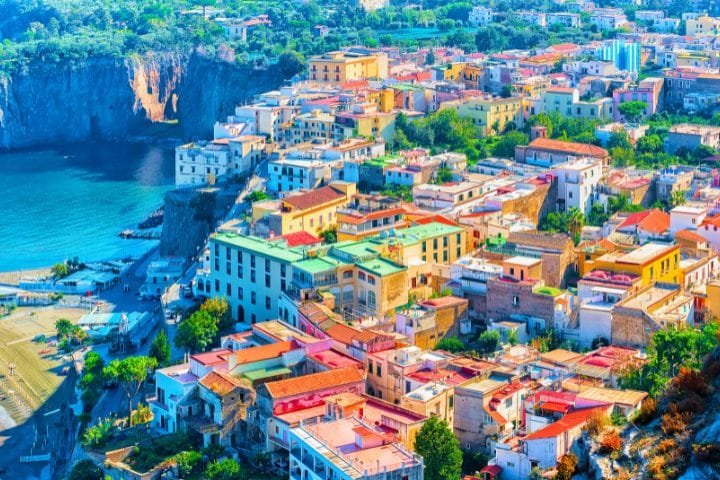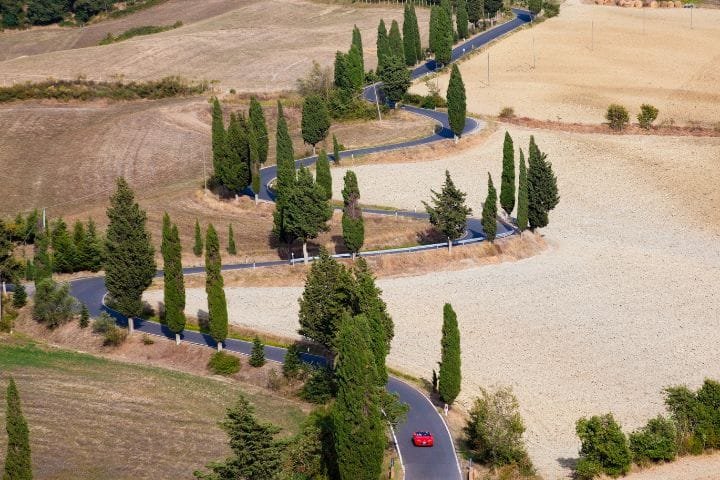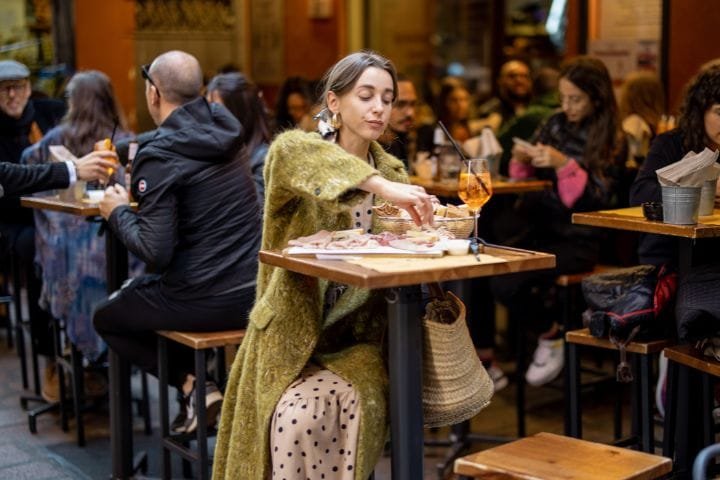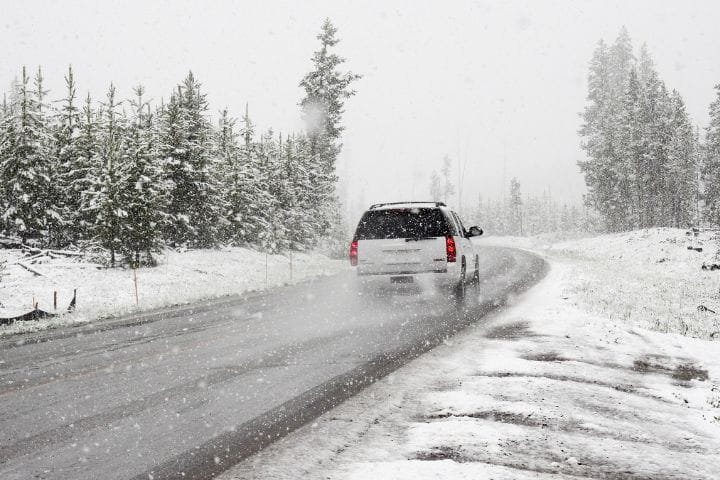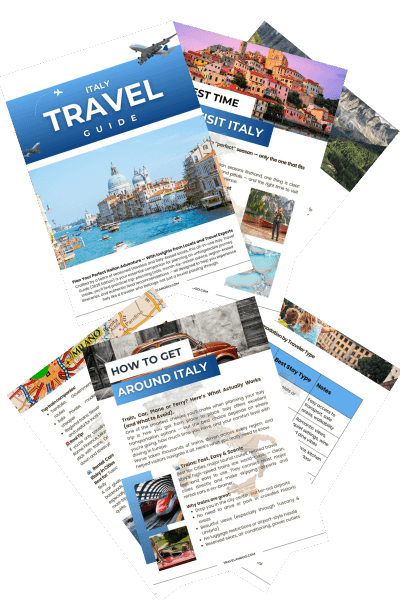Puglia Road Trip Itinerary: Explore Italy’s Hidden Gem Region (2025)

by Mary | Last Updated December 9, 2025
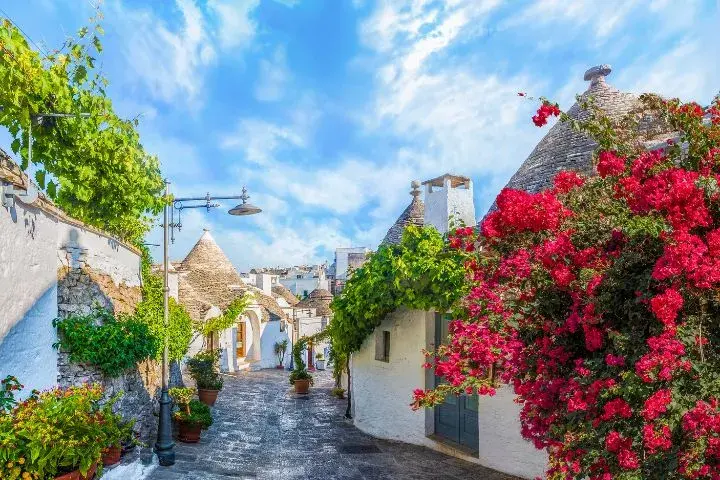
Ready to discover Italy’s best-kept secret? After exploring over 40 countries and countless Italian regions, I can confidently say that Puglia – the “heel of Italy’s boot” – offers one of the most rewarding and authentic road trip experiences in Italy and all of Europe, without the crowds and inflated prices you’ll find in Tuscany or the Amalfi Coast.
This stunning southern region remains blissfully undiscovered by mass tourism, yet delivers everything you could want from an Italian adventure: UNESCO World Heritage sites, pristine beaches, incredible cuisine, and warm, welcoming locals who still seem genuinely surprised to meet international visitors.
Did you know that Puglia produces more olive oil than any other region in Italy and boasts over 800 kilometers of spectacular coastline along both the Adriatic and Ionian seas?
From the fairy-tale trulli houses of Alberobello to the baroque splendor of Lecce, from the dramatic limestone cliffs of Polignano a Mare to the ancient cave dwellings of Matera, this region offers diversity and authenticity that’s increasingly rare in modern Italy.
Whether you’re drawn by the promise of empty beaches, fascinated by unique architecture, or simply seeking that elusive “real Italy” experience away from the tourist crowd, Puglia delivers in spades.
Let’s craft the perfect Puglia road trip itinerary that showcases this remarkable region’s highlights while leaving time for those magical, spontaneous discoveries that make travel truly memorable!
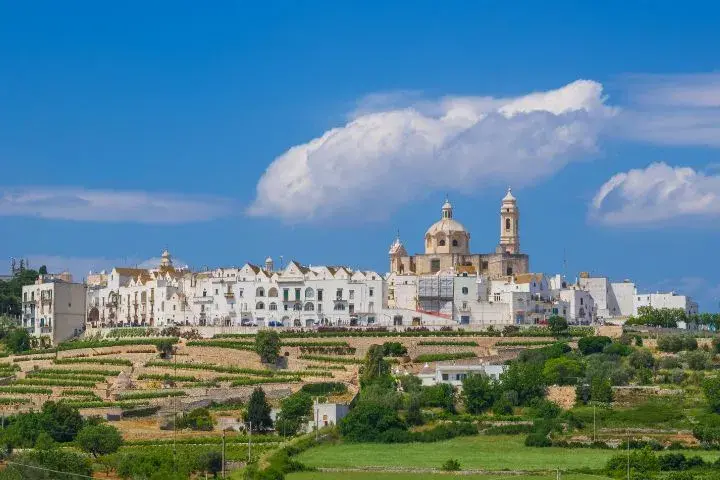
Puglia Road Trip Overview: When to Visit and How Long to Stay
Best seasons for Puglia are absolutely magical during late spring (April-June) and early fall (September-October). I’ve visited during both periods, and each offers distinct advantages. Spring brings wildflowers carpeting the countryside, the weather is ideal for road trips, and locals re-emerge from winter with an infectious, lively energy. Fall delivers warm sea temperatures, harvest season festivities, and that golden Mediterranean light that makes everything look like a Renaissance painting.
The ideal trip duration depends on your travel style. Still, I recommend a minimum of 7-10 days to truly appreciate Puglia’s diversity. Rushed travelers can hit highlights in 5-6 days, while those seeking deeper cultural immersion should plan 10-14 days. The region’s compact size makes it perfect for a focused exploration – you can drive from the northern trulli country to the southern tip in just 3 hours.
Weather considerations are crucial for planning. July and August bring scorching heat and peak Italian tourism, making accommodations expensive and beaches crowded. Winter (December-February) sees many coastal restaurants and attractions closed, though you’ll have historic cities virtually to yourself. Spring and fall offer the best balance of pleasant weather, open attractions, and manageable crowds.
Regional transportation centers on car rental, which I highly recommend for maximum flexibility. Puglia’s train system is limited, and many of the region’s most beautiful spots are only accessible by car. Major car rental companies operate from Bari and Brindisi airports, with smaller local companies often offering better rates and personalized service.
Budget planning for Puglia is refreshingly reasonable compared to northern Italy. Expect to spend €80-120 per day per person for mid-range accommodations, meals, and activities. Trulli house rentals and masseria stays can be surprisingly affordable when shared among groups, while eating at local trattorias costs a fraction of tourist restaurant prices in Florence or Rome.
🧭 Plan the Perfect Puglia Road Trip
- Start with the ultimate Italy road trip planning guide → How to Plan a Perfect Italy Road Trip: Complete Guide
- Choose the best car for coastal & rural roads → Best Car for Italy Road Trip – Complete Guide
- Avoid ZTL fines in historic centers like Bari & Lecce → Italy ZTL Zones Driving Guide
Northern Puglia: Trulli Country and Baroque Cities (Days 1-3)
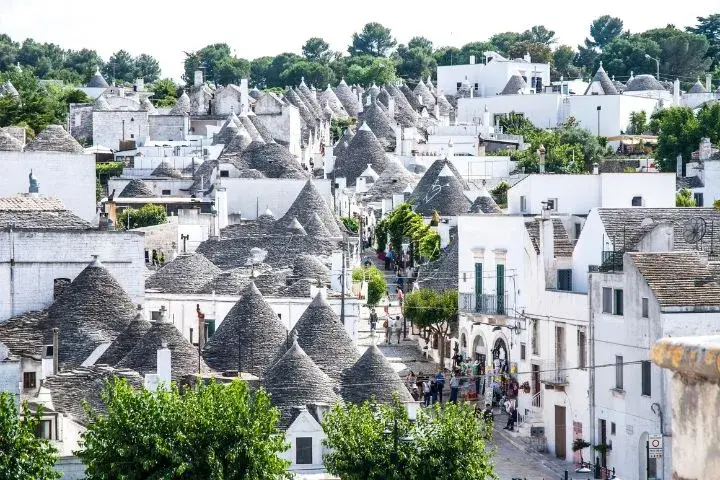
Alberobello serves as the perfect introduction to Puglia’s unique character. These UNESCO-listed trulli houses look like something from a fairy tale – conical stone roofs, white walls, and mystical symbols painted on roof peaks. I spent my first night in an authentic trulli house rental, and waking up in that otherworldly environment immediately transported me into Puglia’s magic.
The town divides into two main areas: Rione Monti (touristy but necessary to see) and Aia Piccola (a more authentic residential area). Visit early morning or late afternoon to avoid day-trip crowds from Bari. The Trullo Sovrano offers museum insights into traditional construction, while local shops sell regional specialties like burrata cheese and taralli crackers.
Locorotondo enchanted me with its perfectly circular historic center and stunning valley views. This white-washed town perched on a hill exemplifies Puglia’s architectural harmony – every building follows traditional designs that create visual cohesion rare in modern Italy. The historic center takes just 2-3 hours to explore, making it perfect for a morning visit combined with wine tasting at the surrounding vineyards.
Martina Franca represents Puglia’s baroque architectural pinnacle outside of Lecce. The Palazzo Ducale and Basilica di San Martino showcase the region’s 17th-century prosperity through elaborate stone carvings and decorative facades. I discovered some of my best meals here at family-run trattorias serving traditional Puglian cuisine at incredibly reasonable prices.
Ostuni earned its “White City” nickname through mandatory white-painted buildings that create a stunning contrast against azure skies. The historic center’s maze of narrow streets rewards exploration with hidden piazzas, ancient churches, and panoramic viewpoints. Time your visit for sunset when the white buildings glow golden against the surrounding olive groves.
Driving routes between these towns follow scenic country roads lined with ancient olive trees, dry stone walls, and traditional trulli scattered across the landscape. Allow extra time for spontaneous photo stops and discoveries – some of my best Puglia memories came from unplanned encounters with local farmers or artisans along these rural routes.
🏛️ Unique Villages & Hidden Marvels
- Add more authentic inland towns & quiet roads → Hidden Gems Italy Road Trip Itinerary
- Turn this into a romantic getaway → Romantic Italy Road Trip Itinerary
Central Puglia: Coastal Gems and Historic Ports (Days 4-6)
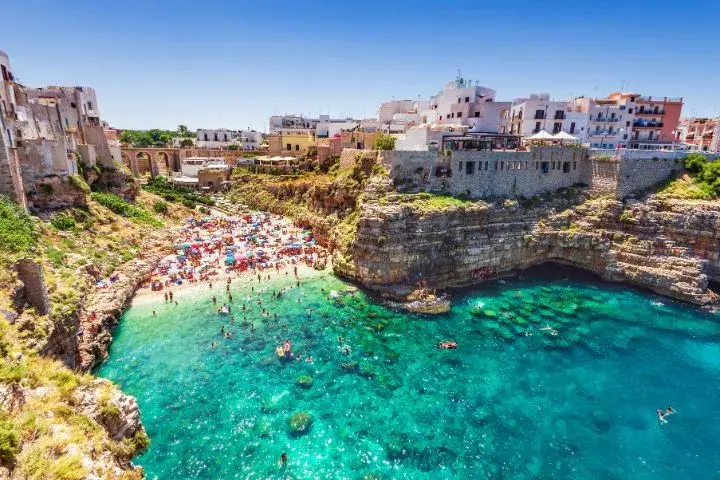
Polignano a Mare absolutely took my breath away with its crystal-clear waters and dramatic limestone cliffs. The town perches precariously on cliffs overlooking the Adriatic Sea, creating some of Italy’s most spectacular coastal scenery. The famous beach nestled between cliffs offers incredible swimming, though it gets crowded during peak season.
I recommend staying for sunset aperitivo at one of the cliff-top bars – the combination of golden light, dramatic coastline, and excellent local wine creates one of those perfect travel moments. The historic center, while small, offers charming restaurants and shops selling local crafts and food specialties.
Monopoli surprised me as one of Puglia’s most authentic ports, where fishing boats still dominate the harbor and local life continues largely unchanged by tourism. The old town combines medieval architecture with baroque churches, while the working port provides fascinating glimpses into traditional maritime culture.
The local fish market operates early morning (6-9 AM) and offers incredible insights into regional seafood. Several excellent restaurants surround the port, serving the day’s catch in traditional preparations that highlight Puglia’s coastal cuisine strengths.
Conversano showcases Norman and medieval architecture in a setting that feels completely authentic and untouched by mass tourism. The medieval castle dominates the town center, while narrow streets reveal hidden churches and traditional workshops. I spent a delightful afternoon here, simply wandering and discovering local artisans who still practice traditional crafts.
Castellana Grotte provides a fascinating underground adventure through extensive limestone cave systems. The 90-minute guided tour reveals spectacular formations and underground chambers that offer cool relief during hot summer days. The experience offers an intriguing geological context for understanding Puglia’s distinctive karst landscape.
Coastal driving along this stretch offers numerous opportunities for beach stops and scenic photography. The coastline alternates between sandy beaches and rocky cliffs, with many spots accessible only by car. I discovered several unmarked beach access points that provided private swimming opportunities away from organized beach clubs.
🌊 Epic Beaches & Seaside Drives
- Combine with more coastal Italy routes → Italy Coastal Road Trip — Seaside Routes
- For a long Italy journey including Puglia → Italy Road Trip 2 Weeks — Complete Guide
Southern Puglia: Lecce and the Salento Peninsula (Days 7-10)
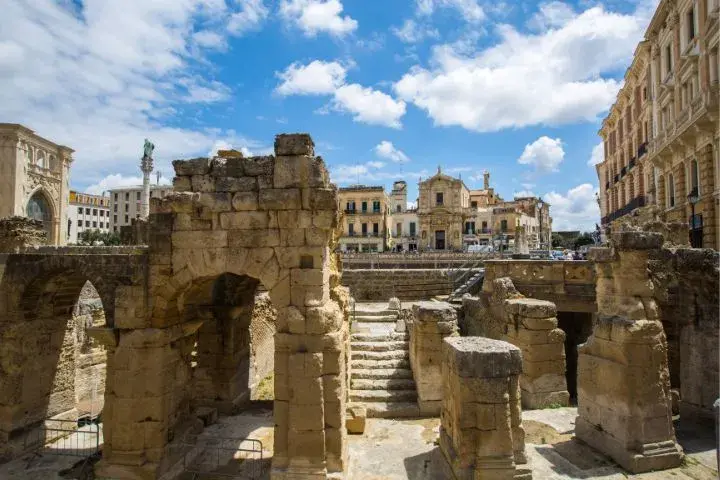
Lecce absolutely deserves its reputation as the “Florence of the South” through an incredible concentration of baroque architecture unmatched anywhere in southern Italy. The local pietra leccese (Lecce stone) allows for intricate carving that creates facades of remarkable detail and beauty. I spent two full days exploring churches, palaces, and hidden courtyards, each revealing new architectural marvels.
The Basilica di Santa Croce represents the pinnacle of Lecce baroque with its incredibly detailed facade covered in carved figures, animals, and decorative elements. The Roman amphitheater in Piazza Sant’Oronzo provides fascinating historical context, while the Castello Carlo V offers panoramic city views.
Otranto holds special significance as Italy’s easternmost city and gateway to the Balkans throughout history. The cathedral’s stunning mosaic floor tells biblical stories through thousands of colorful tiles, while the Turkish massacre memorial provides sobering historical context. The coastal setting offers beautiful beaches and crystal-clear waters perfect for swimming.
Plan Your Trip with Our Favorite Booking Tools
Gallipoli is divided between the modern mainland and the historic island fortress, connected by a bridge. The old town’s maze of narrow streets, ancient churches, and defensive walls creates an atmospheric setting perfect for evening exploration. The surrounding Ionian coast offers some of Puglia’s most beautiful beaches with fine sand and clear waters.
Santa Maria di Leuca marks the symbolic meeting point of the Adriatic and Ionian seas at Italy’s southernmost tip. The lighthouse and sanctuary create a dramatic setting for contemplating the vastness of the Mediterranean. The surrounding coastline offers excellent swimming and several coastal walking trails.
Salento countryside reveals traditional agricultural life continuing largely unchanged for generations. Small villages like Specchia and Presicce offer authentic glimpses into rural Puglia culture, while the landscape showcases traditional dry stone walls, ancient olive groves, and wild Mediterranean vegetation.
Essential Puglia Experiences and Activities
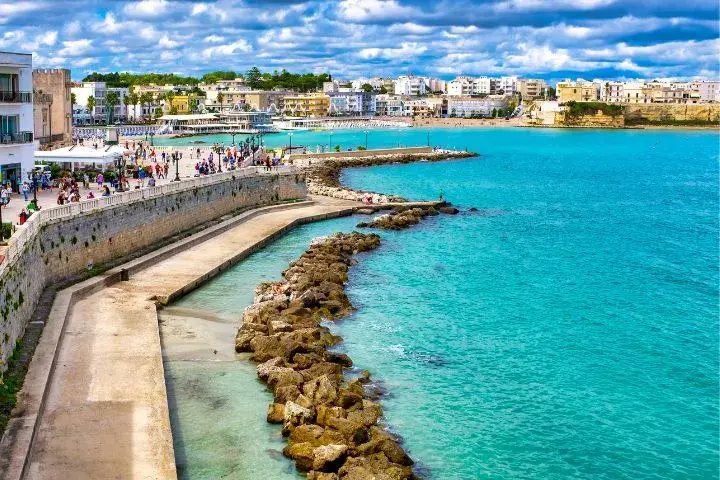
Olive oil farm tours provide fascinating insights into production methods that have remained unchanged for centuries. Several farms around Ostuni and Alberobello offer tastings and tours that explain the connection between terroir, variety, and flavor. I participated in a harvest experience that included traditional pressing techniques and extensive tastings paired with local breads and cheeses.
Traditional masseria stays offer luxury accommodations in restored farmhouses that showcase Puglia’s agricultural heritage. These properties typically feature beautiful pools, excellent restaurants, and peaceful rural settings perfect for relaxation. Many offer cooking classes, wine tastings, and cultural activities that provide deeper regional insights.
Local food specialties include an incredible variety reflecting both land and sea influences:
- Orecchiette pasta with broccoli rabe (regional signature dish)
- Burrata cheese (invented in Puglia and best consumed fresh)
- Focaccia barese (thick, soft bread with tomatoes and olives)
- Fresh seafood, including sea urchins and octopus
- Pasticciotto (custard-filled pastry from Lecce)
Beach recommendations vary by preference. The Adriatic coast offers dramatic cliffs and clear waters, while the Ionian coast provides sandy beaches and calmer conditions. Porto Badisco, Baia dei Turchi, and Punta Prosciutto rank among the most beautiful, though expect crowds during peak season.
Cultural festivals throughout the year celebrate everything from religious traditions to food specialties. The La Notte della Taranta music festival in August showcases traditional pizzica dancing, while various food festivals highlight local specialties like burrata, olive oil, and wine.
Practical Driving Tips for Puglia
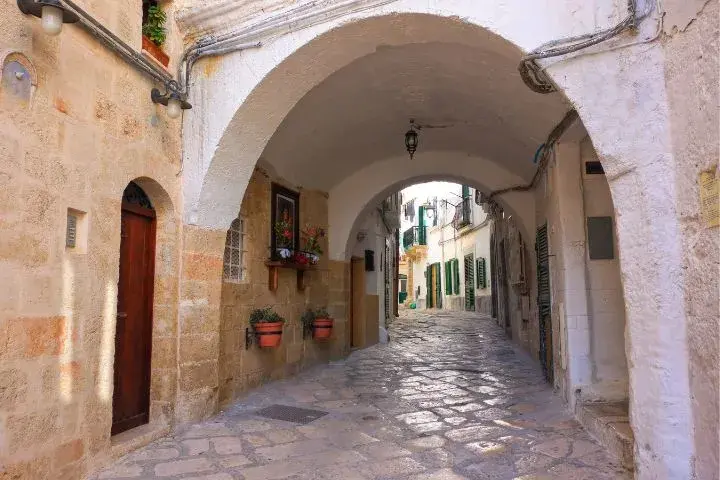
Road conditions throughout Puglia are generally excellent, with modern highways connecting major cities and well-maintained secondary roads serving smaller towns. However, historic centers often have very narrow streets unsuitable for large vehicles, so consider compact car rentals for easier navigation and parking.
Parking strategies require planning in popular destinations. Many historic centers restrict vehicle access, but designated parking areas usually exist just outside old town boundaries. Alberobello and Polignano a Mare can be particularly challenging during peak season, so arrive early or visit during off-peak hours.
Navigation considerations include GPS reliability in rural areas and the importance of downloading offline maps for backup. Many agriturismo properties and rural accommodations are located on unmarked country roads that GPS systems struggle to locate accurately.
Local driving customs are generally more relaxed than in northern Italy. However, summer tourist traffic can create congestion in popular coastal areas. Speed limits are well-marked and generally respected, while local drivers are typically patient with obvious tourists navigating unfamiliar territory.
Emergency contacts include standard Italian emergency numbers (112 for general emergencies, 118 for medical emergencies), plus local traffic police and car rental company contacts. Most major towns have hospitals or medical facilities, though rural areas may require longer travel times for serious emergencies.
🚗 Stay Safe on Narrow Coastal & Countryside Roads
- Brush up on speed limits before driving → Speed Limits in Italy for Tourists
- Understand car insurance requirements before renting → Car Insurance Requirements in Italy
Where to Stay: Accommodation Recommendations
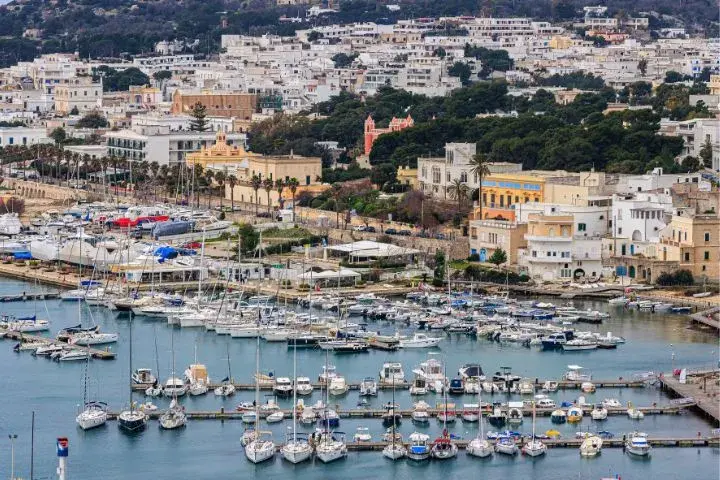
Trulli house rentals provide the most authentic Puglia experience, with numerous properties available around Alberobello and throughout the Itria Valley. These unique accommodations range from basic traditional houses to luxury properties with pools and modern amenities. Book well in advance for peak season, as the most atmospheric properties fill up quickly.
Masseria luxury experiences offer incredible value compared to similar properties in Tuscany or the Amalfi Coast. These restored farmhouses typically feature beautiful pools, excellent restaurants, and peaceful rural settings. Many offer activities like cooking classes, wine tastings, and cultural excursions that provide deeper regional insights.
Historic center hotels in cities like Lecce and Ostuni provide convenient access to major attractions while offering comfortable accommodations in restored palaces and traditional buildings. These properties often feature beautiful courtyards, rooftop terraces, and architectural details that enhance the cultural experience.
Coastal resort options along both the Adriatic and Ionian coasts offer beach access and water sports activities. These properties range from luxury resorts to family-run hotels, with many featuring private beach access and seaside restaurants serving fresh seafood.
Budget-friendly alternatives include agriturismos (farm stays) that offer authentic rural experiences at reasonable prices. Many provide meals featuring farm-produced ingredients, while others offer activities like olive oil production or traditional cooking classes.
Food and Wine: Puglia’s Culinary Highlights
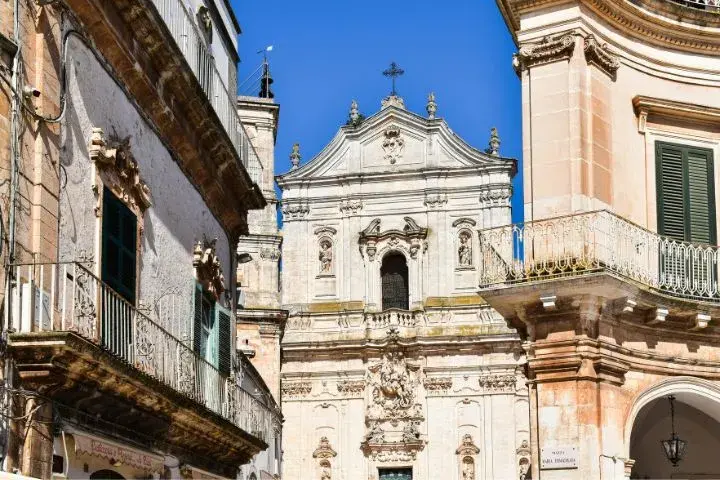
Regional specialties reflect Puglia’s position as Italy’s agricultural powerhouse and its extensive coastline. The cuisine emphasizes fresh, simple ingredients prepared with techniques passed down through generations. Bread plays a central role, with varieties like focaccia barese and taralli serving as both snacks and meal accompaniments.
Wine regions throughout Puglia produce excellent varieties that remain largely undiscovered by international markets. Primitivo and Negroamaro represent the flagship red varieties, while Verdeca and Bombino Bianco create excellent whites. Many vineyards offer tastings and tours that provide insights into traditional winemaking techniques.
Local markets in cities like Lecce and Bari offer incredible variety and provide excellent opportunities for cultural interaction. These markets typically operate in the morning hours and feature everything from fresh produce to regional specialties like burrata cheese, olive oil, and traditional pastries.
Restaurant recommendations focus on family-run trattorias serving traditional cuisine at reasonable prices. Many of my best meals came from small establishments recommended by locals rather than tourist-oriented restaurants. Always ask about daily specials featuring seasonal ingredients and fresh seafood.
Cooking classes offered by various accommodations and cooking schools provide hands-on learning about regional techniques and ingredients. These experiences typically include market visits, preparation instruction, and meals featuring the dishes you’ve learned to prepare.
Discovering Puglia’s Authentic Magic
After exploring countless destinations worldwide, I can confidently say that Puglia offers one of those increasingly rare travel experiences where you feel like you’re discovering something genuinely special and relatively untouched.
This region provides everything you could want from an Italian adventure – incredible history, stunning architecture, beautiful beaches, amazing food, and warm hospitality – without the crowds and commercialization that have transformed many other Italian destinations.
The key to a successful Puglia road trip is embracing the region’s relaxed pace and allowing time for spontaneous discoveries. Some of my best memories came from unplanned encounters: discovering hidden beaches along coastal drives, or stumbling upon village festivals that provided authentic cultural insights.
Most importantly, Puglia reminds you why you fell in love with Italy in the first place. The combination of stunning beauty, rich culture, incredible food, and genuine warmth creates travel experiences that feel both exotic and deeply satisfying. This region proves that Italy still has secrets to share with curious travelers willing to venture beyond the well-trodden tourist paths.
Pack your appetite for adventure, your camera for capturing incredible beauty, and prepare to fall in love with Italy’s most authentic and welcoming region. Puglia won’t disappoint – it will exceed your expectations and create memories you’ll treasure forever.
FAQs on Puglia Road Trip Itinerary
How long should I spend in Puglia, and when is the best time to visit?
Plan minimum 7-10 days to see Puglia’s highlights, or 10-14 days for deeper exploration. Best times are late spring (April-June) and early fall (September-October) for perfect weather, open attractions, and manageable crowds.
Avoid July-August due to extreme heat and peak tourism, while winter sees many coastal restaurants closed. Spring brings wildflowers and energetic locals, and fall offers warm sea temperatures and harvest festivals.
What are the must-see destinations in Puglia?
Northern Puglia: Alberobello (UNESCO trulli houses), Ostuni (white city), Locorotondo (circular town). Central: Polignano a Mare (dramatic cliffs), Monopoli (authentic fishing port).
Southern: Lecce (baroque architecture masterpiece), Otranto (easternmost city), Gallipoli (island fortress). Each area offers distinct character – trulli country, coastal gems, and baroque cities. Allow 2-3 days per region.
Where should I stay in Puglia for the best experience?
Stay in authentic trulli houses around Alberobello for a unique architectural experience. Luxury masseria (farmhouse) stays offer pools, excellent restaurants, and cultural activities at great value.
Historic center hotels in Lecce and Ostuni provide walkable access to attractions. Coastal resorts offer beach access. Book trulli and masseria properties well in advance for peak season.
What are Puglia’s food specialties, and where should I eat?
Must-try: Orecchiette pasta with broccoli rabe, fresh burrata cheese (invented here), focaccia barese, fresh seafood, and pasticciotto pastries from Lecce. Eat at family-run trattorias recommended by locals rather than tourist restaurants.
Visit morning markets in Lecce and Bari for fresh produce and regional specialties. Many masseria and cooking schools offer hands-on classes.
Do I need a car for Puglia, and what should I know about driving?
Yes, a car is essential for maximum flexibility – many beautiful spots are only accessible by car, and train service is limited. Roads are generally excellent, with modern highways and well-maintained secondary roads. Historic centers have narrow streets, so rent compact cars. Download offline maps for rural areas. Allow extra time for spontaneous stops along scenic country roads lined with olive trees.
💬 We’d love to hear from you!
Have questions, tips, or personal travel stories to share? Drop them in the comments below — your insights help fellow travelers plan their adventures too.


